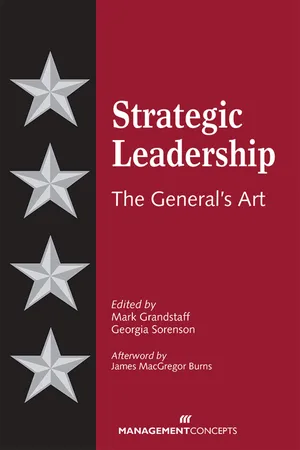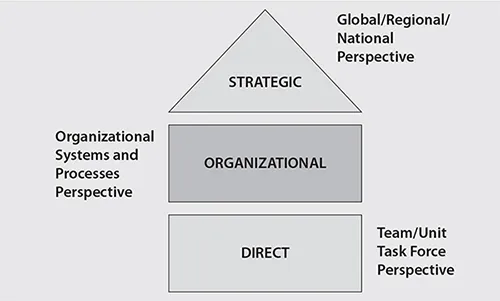![]()
PART I
A Culture of Leadership
![]()
CHAPTER 1
Creating a Culture of Leadership Development
George E. Reed, PhD
During the first weeks of Operation Iraqi Freedom, Sergeant First Class Paul R. Smith led an engineer unit as part of an infantry task force that was advancing toward the Baghdad airport. While constructing an enemy prisoner of war holding area, the unit was attacked by a force of over a hundred enemy fighters armed with automatic weapons and rocket-propelled grenades. Outnumbered and nearly surrounded, Sergeant Smith engaged the enemy with grenades, an antitank weapon, and small arms while directing the fire and movements of his soldiers. After several of his soldiers were injured, he realized that the enemy had the upper hand. Sergeant Smith then climbed into the hatch of a disabled armored vehicle and exposed himself to enemy fire in order to employ a .50 caliber machine gun in an attempt to delay the advance. He was successful in disrupting the enemy attack, but in the process he was mortally wounded.
His fellow soldiers honored him for his courageous leadership and for saving the lives of his men. Sergeant Smith’s sister later recounted that he “had an incredible love for the troops under his command. . . . In the last letter that Paul Smith wrote from Iraq to our parents, he told them that now that he was a father himself, he realized just how much they had sacrificed to make his life a good life and he thanked them for that special effort. He spoke of being prepared to give—as he said—‘all that I am, to ensure that all my boys make it home.’ In that same letter, he told our parents how proud he was of the ‘privilege to be given 25 of the finest Americans we call Soldiers to lead into war,’ and he recognized their fears and his responsibilities for their welfare.”1 Congress celebrated his sacrifice by awarding him the nation’s most revered medal—the Medal of Honor. In a touching ceremony at the White House, his wife and children received the medal in his stead.
One might well ask, “What do the actions of a senior noncommissioned officer, heroic as they are, have to do with strategic leadership or culture development in a large and complex organization?” The question reflects a common misunderstanding about levels of leadership. The actions of strategic leaders have a direct connection to, and impact on, those on the front line. Sergeant Smith’s actions demonstrate that such efforts to imbue a warrior ethos and develop responsible leaders of character make a difference. Long before Sergeant Smith’s unit took to the field, strategic leaders had created a culture of leadership development by providing a vision and example of what Army leaders should be, know, and do. They then defined requirements and allocated the financial resources for leadership schools and courses.
The public and private sectors outside the military are increasingly recognizing the value of strategic leadership as a means to obtain a competitive edge in a volatile and unpredictable environment. A 2004 Executive Development Trends survey identified the following top objectives for executive development in the next two to three years: (1) increasing bench strength, (2) accelerating the development of high-potentials, (3) communicating vision and strategy, (4) supporting change and transformation, and (5) developing individual leader capabilities.2 Furthermore, in a 2005 survey, respondents were asked to identify gaps in the next generation’s capabilities. Deficiencies most frequently cited included:
Ability to create a vision and engage others so they feel ownership and passion about achieving it (58 percent)
Understanding of the total enterprise, how the different parts work together to leverage their collective capabilities to serve customers/clients better than the competition (56 percent)
Strategic thinking (55 percent)
Cooperation and collaboration with other parts of the business to (1) optimize the operations of our business and (2) to leverage our collective capabilities in the marketplace to identify and serve customers/clients better than the competition
Leadership (46 percent).
3The Army has taught these principles to its future leaders for a long time. While it is true that the Army is not a business in a conventional sense, as an enterprise it faces challenges that global business leaders would easily recognize. The Army is as a large and complex organization of 1.23 million members spread across 17 strategic business units operating in 120 countries. It operates with a budget of over $100 billion in fiscal year 2006, and it faces a high-risk, competitive, dangerous, and rapidly changing environment. Moreover, a recent Korn/Ferry report found that many former military members serve in the private sector as chief executive officers. This alone attests to the fact that leadership skills learned in the military enhance success in corporate life. Key military leadership traits that translate well to business leadership include learning how to work as part of a team; organizational skills, such as planning and effective use of resources; good communication skills; defining a goal and motivating others to follow it; a highly developed sense of ethics; and the ability to remain calm under pressure.4
WHAT IS A CULTURE OF LEADERSHIP?
A culture of leader development exists when supervisors agree that it is their duty to develop their subordinates to meet their full potential, and when organization members at all levels strive to achieve the next level of responsibility. There must be a commitment that development remain a priority, even in the midst of budgetary and operational pressures. Certain personnel policies and resource decisions, coupled with constant emphasis by senior leaders, should further reinforce this commitment.
Several policies and mechanisms in the Army combine to powerfully reinforce this type of culture:
A shared framework and vocabulary for thinking and talking about leadership (leadership doctrine).
A three-part model for leader development consisting of institutional training and education, operational assignments, and self-development.
A sequential and progressive system of training and education through well-resourced institutional schools and courses (the system of professional military education).
Assignment policies that maximize development by ensuring that all members progress through steadily increasing positions of responsibility.
Funding for education and training that is centralized. Costs are transparent to the sending organization.
Organizations that do not suffer extended personnel losses when sending personnel to schools and courses.
Promotions and key assignments tied to successful completion of professional schools and courses.
Leaders responsible for developing leaders. Leader development is not simply a human resources function.
Personnel policies which require that to remain in the organization, members must be promoted within a specified period of time (“up or out”).
THE ARMY’S LEADERSHIP FRAMEWORK
In the Army, clear lines of supervision are considered a virtue, while status, prestige, and power are largely distributed on the basis of rank and position. It should not be a surprise, then, that the Army leadership framework takes a stratified approach to the phenomenon (Figure 1-1). In other words, the Army leadership framework considers three levels of leadership: direct (or tactical level, which is focused at the team or unit level); organizational (focused on systems and processes); and strategic (global or regional perspective).5
These levels of leadership have strong face validity to anyone who has tried to make a transition from first-line supervisor to middle manager or from mid-level to executive leadership. What makes a person successful at one level will not ensure success at the next. There may even be skills and abilities that are highly rewarded at one level but that can be disastrous at other levels. As an example, quick decision-making with limited information, accompanied by technically competent and forceful execution, is a virtue at the tactical (or direct) level; at the strategic level, however, patience, negotiation, and consensus, combined with synthesis and integration skills, are absolutely necessary. This then sets an organizational imperative to prepare individuals for the demands of different levels and provides a framework for building a system of professional schools and courses.
FIGURE 1-1. Army leadership framework.
The Army also makes an extensive investment in the education and development of its leaders. Over a 20-year career, a typical Army officer might spend 4 years or more in schools and courses that sometimes include fully funded graduate studies in civilian universities. Although there are differences between officers, noncommissioned officers, and the civilian workforce, all have access to a system of professional development schools and courses. This is a massive investment when you consider the operational demands the Army faces during times of conflict. Some of the more extensive school programs, such as the U.S. Army War College, last for up to ten months, a period during which many of the “best and brightest” are unavailable for field assignments or missions.6
The Army, like all branches of the military, has a system of sequential schools and courses that are specifically designed to help leaders prepare for the next level of responsibility. Where there are known transition points, such as from enlisted soldier to noncommissioned officer, or from junior officer to field grade, there is a mandatory school to prepare them. These courses are not simply offered as options; they are prerequisites or “gateways” that must be completed before serving at the next level. They are considered rewards for effective performance and an essential preparation for promotion.
Education is thus tightly linked to a personnel system that handles promotions and selection for key assignments. Personnel policies serve as important drivers of organizational culture in the Army. Two are especially important: the “up or out” policy, which mandates that soldiers must either be promoted within a specified period of time or leave, and the lack of a mechanism to hire those from outside the organization into senior leadership positions. There are no career privates in the Army. Every soldier is preparing for promotion to the next level of responsibility. One either moves up the promotion ladder or is out of the Army. Given that one does not, under normal circumstances, qualify for retirement benefits until one has 20 years of service, there is a powerful motivation to make progress. Being passed over for promotion sends a clear message that one should look for another job.
When that policy is combined with the harsh realities of the battlefield, which demand that subordinates stand ready to assume the role of a wounded leader, the Army has compelling reasons for ext...















